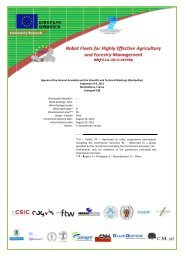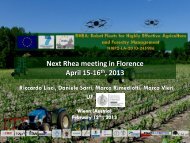1st Workshop BOOK - project RHEA
1st Workshop BOOK - project RHEA
1st Workshop BOOK - project RHEA
You also want an ePaper? Increase the reach of your titles
YUMPU automatically turns print PDFs into web optimized ePapers that Google loves.
Robotics and associated High technologies and Equipment for Agriculture<br />
The final decision on field spraying depends heavily on weather conditions.<br />
Consequently, the system includes a set of decision rules based on the expected<br />
wind, temperatures and rainfall at treatment time and in the following 24 h (Fig. 4).<br />
5. Step 4: Unit distribution & path planning<br />
Numerous planning methods for obtaining the routes that allow an efficient<br />
operation of agricultural vehicles have been proposed (Stoll, 2003; Jin and Tang,<br />
2010; Taix et al., 2006). These methods take into account, for only one vehicle,<br />
different factors: the strategy of operation, the surrounding areas, the geometry of<br />
the field, field-specific data (size, slope, obstacles in the field), specific restriction<br />
on the machinery (p.e. turning radius), or the operation direction. The change of<br />
the direction in the headlands is an important issue because of the long time<br />
needed for this operation. Stoll (2003) has calculated the turning paths keeping in<br />
mind the effective width, the minimum turning radius, the driving speed and the<br />
turning acceleration of the vehicle. It also includes additional time to consider the<br />
change of the direction in the turning.<br />
Path planning taking into account the previous factors is a very complex process<br />
that requires rather sophisticated tools in order to search the optimal solution. The<br />
problem becomes even more complex when a fleet of robots is used to perform<br />
the herbicide treatment. The problem can be enunciated as follows (Conesa-Muñoz<br />
and Ribeiro, 2011): Given a set of robots with certain features (i.e., herbicide<br />
loading capacity, motion characteristics, width of the spraying boom), a field with<br />
specific dimensions, a crop growing in rows and a map of the weed patches, the<br />
aim is to find the subset of robots and associated paths that ensure the whole<br />
cover of the weed with the minimum cost (Fig. 5). The solution of this problem can<br />
be faced with a genetic algorithm approach where the fitness function considers<br />
several of the factors above explained (Conesa-Muñoz and Ribeiro, 2011).<br />
6 Step 5: Online decisions<br />
Although the prescription map provides basic information of the field areas that<br />
should be sprayed, this information needs to be contrasted with that obtained at<br />
spraying time with cameras or sensors that detect weed presence and discriminate<br />
different weed types. Once the detected weed patch has been considered as a<br />
suitable target for spraying, a fast-response controller will regulate discharge of the<br />
different herbicides in each individual nozzle (Fig. 6). Decision making could be<br />
made using a set of decision rules similar to those used in the long-term decision<br />
module.<br />
9




